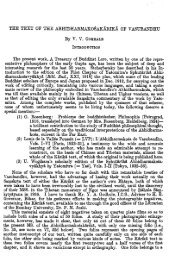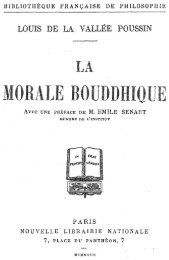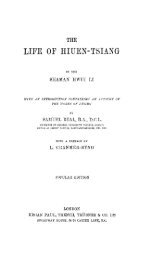La Vallée Poussin Musīla and Nārada. The Path - Gampo Abbey
La Vallée Poussin Musīla and Nārada. The Path - Gampo Abbey
La Vallée Poussin Musīla and Nārada. The Path - Gampo Abbey
You also want an ePaper? Increase the reach of your titles
YUMPU automatically turns print PDFs into web optimized ePapers that Google loves.
Musıla <strong>and</strong> N›rada. <strong>The</strong> <strong>Path</strong> of Nirv›˚a: by Louis de <strong>La</strong> <strong>Vallée</strong> <strong>Poussin</strong><br />
• ‘Equipoise of cessation’ is one of six unconditioned phenomena (asa˙sk¸ta) in the list of One<br />
30<br />
Hundred Factors: a way of designating suchness (tathat›), Siddhi by Hsüan-tsang, 75.<br />
• <strong>The</strong> Mah›s›˙ghikas do not count the ‘equipoise of cessation’ in their list of nine<br />
unconditioned phenomena (asa˙sk˛ra), but definitely the four formless equipoises (asa˙sk¸tas<br />
4-7), see Masuda, Treatise of Vasumitra, 29 (Asia Major, II, 1925).<br />
a. Aºguttara, IV, 454:<br />
What is needed for there to be nirv›˚a-in-this-life? – <strong>The</strong> practitioners enter into the first<br />
meditation… into the fourth formless equipoise: that is what the Blessed One calls,<br />
figuratively, nirv›˚a-in-this-life. <strong>The</strong> practitioners enter into the ‘equipoise of cessation’, <strong>and</strong><br />
their fluxes have been destroyed by the vision of discrimination (paññ›ya disv›): that is what<br />
the Blessed One calls, not figuratively (nippariy›yena), nirv›˚a-in-this-life.<br />
Aºguttara, IV, 414:<br />
⁄›riputra says to the monastics: “Happiness is nirv›˚a! Happiness is nirv›na!”<br />
Ud›yin asks: “But what is happiness in nirv›˚a wherein there is no sensation?”<br />
⁄›riputra answers: “<strong>The</strong> happiness of nirv›˚a is that there is no sensation in nirv›˚a.”<br />
For the monastics who have entered into the first meditation, any conception<br />
connected with the world of desire (k›ma) is trouble, a suffering. [<strong>The</strong> happiness of the first<br />
meditation consists of the elimination of this conception.] By this distinction (imin›<br />
pariy›yena), we can know how nirv›˚a is happiness. – And so on up to the monastics who<br />
enter the fourth formless equipoise. – Going beyond the fourth formless equipoise, the<br />
monastics enter into the ‘equipoise of cessation’ <strong>and</strong> their fluxes have been destroyed by the<br />
vision of discrimination: by this distinction we also may know how nirv›˚a is happiness.<br />
[An unexpected conclusion which is at variance, it seems, with sÒtra IV, 454.]<br />
b. Visuddhimagga, 705.<br />
Why do practitioners enter into this equipoise? Wishing for the breaking of the procession of<br />
existence (or of the conditioning forces, sa˙sk›ras), they enter into it hoping: “Already in the<br />
present existence, having become free from mind, attaining cessation (nirodha), nirv›˚a, we<br />
will pass the time happily (di˛˛heva dhamme acittak› hutv› nirodha˙ nibb›na˙ patv› sukha˙<br />
vihariss›m›ti)”.<br />
c. She Zan Aung, in Compendium, 70.<br />
If the practitioners are not satisfied with the mere intuition of nirv›˚a that accompanies the<br />
possession of the fruit of a perfect being (arhat), they can enter into the ‘equipoise of<br />
cessation’; they can enjoy nirv›˚a already in the present existence (di˛˛hadhammanibb›na);<br />
they can partially enjoy nirv›˚a. When the practitioners emerge from concentration in the






